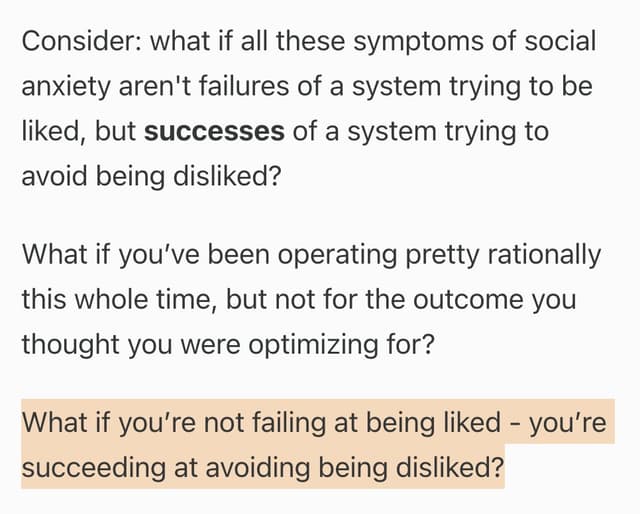🧵 View Thread
🧵 Thread (33 tweets)

Locally optimal psychology There’s no way that chronic depression, self-loathing, poor agency, or muscle tension could be *optimal*… right? Jake was depressed for 6 months. He also felt horrible every time he interacted with other people because of his emotional insecurities. So without knowing how to outgrow his insecurities, his system basically had two options: 1. Interact with other people — and constantly feel horrible 2. Don’t interact with anyone unless absolutely necessary So his system converged on the second option, also known as “depression”. Depression certainly wasn’t the globally optimal strategy, but given the options, it was a locally optimal strategy. [🔴Depression, the best strategy known and accessible at the time.] Once he outgrew his emotional insecurities, however, he was no longer blocked on the better optimum of both interacting with others and not feeling horrible. And so with no need for the ‘depression strategy’, the symptoms evaporated — two years and counting. I know because Jake was me. More examples of locally optimal strategies Most chronic issues for the people I help end up looking like locally optimal strategies. For example, self-loathing often turns out to be a strategy for avoiding conflict with others. Lack of agency often turns out to be a strategy for avoiding judgements of failure. But ideally, they would both have self-love and be safe from conflicts; or have agency and be okay with judgements of failure. I’ve seen people make significant and sometimes total progress in weeks on issues they’ve had for years. One of my tenets is that any persistent mental issue is probably a locally optimal strategy. (Again: if my mind had hit the “undo depression” button while I was depressed, I would’ve gotten hurt!) In my own growth, my issues relating to depression, empathy, conflict avoidance, emotional numbness, eye contact, boundaries, neck pain, and more all turned out to be locally optimal strategies. Only once I fully understood what an issue was doing for me did I make a step change towards resolving it. For example, I had neck pain for 3½ years. A few times it was so bad I couldn’t turn my head. Over the years, I had tried to counteract my neck tension with physical therapy and stretching but nothing really worked. Then, earlier this year I finally realized precisely how it was strategic, so I implemented better strategies towards the same goals and have had ~90% less neck pain since. Btw: Noticing how my neck pain was locally optimal was quite tricky, and even suppressed. So even if an issue IS a locally optimal strategy, it can be quite difficult to understand how. How common are locally optimal strategies? I have no hard data, but I suspect that when an issue has lasted years, local optimality is more probable than not. Why? Consider: If there were no downsides to resolving a persistent issue, then why has it lasted so long?? Thanks to @bjtoomey, @xuenay, @staglynn, @KanizsaBoundary, @AnnaWSalamon, and my clients for support. Further reading on my blog.

@ChrisChipMonk I no longer smoke for about half a year now (and for once it's not during a holiday, resulting in falling back when studies/work starts). I still feel uneasy, like I'm going too slow - difficult to estimate if I am - yet I feel I can't go faster either? https://t.co/AeM7XQX4eZ

@ChrisChipMonk Nice post, good work Chris! Great reminder to be clear about the trades we have to make when we improve. What will you lose? How much will it hurt? What will it be like? Sometimes, it's very hard to make progress if you're not expecting it to feel like pain to begin with.

Full post with links https://t.co/bwRpt6OFZx

@parconley Here are the details on what it looked like for me

I resolved my chronic (3.5y) neck pain two months ago. Now it’s obvious to me that I was creating the tension all along. Here’s my model of what was causing my tension: 1. There would be a feeling in my neck. Like all feelings, the sensation in my neck represented some piece of information meant to be communicated to the rest of my nervous system. Being aware of the feeling seemed to be equivalent to being aware of that piece of information. And I don’t know why, but it happened to manifest spatially within my neck. 2. Some part of me wanted to not feel that feeling. For whatever purpose, some part of me believed being aware of this feeling/information was not okay. 3. It created muscle tension around the feeling. In order to avoid the feeling, that part of me created muscle tension around the location of the feeling in my neck. 4. So the feeling grew. Like all feelings, this one was (and often still is) there in order to be noticed and integrated. Unsurprisingly, the feeling responded to being covered up by tension by making itself more intense. 5. So the tension grew. To avoid the stronger feeling, the part of me creating the tension tensed my neck even more. 6. A feedback loop! So the feeling became stronger… and tension became stronger… and the feeling became stronger…… Yeah, there have been some days in the past few years where my neck was so tense I couldn’t turn my head. What do you mean “I was creating the tension all along”? While I had my neck tension, it did not feel like I was (consciously) doing the steps above. However, a few times since the tension resolved, I’ve caught my neck beginning to tense again in the old way. But I notice as this is happening. And then I notice that I’m labeling the feeling as “harmful” and that I’m trying to avoid the feeling inside my own mind. Because I notice this, I choose to stop labeling the feeling as “harmful”. And instead of avoiding it, I bring my attention into it more. That last mental motion feels like being warm and dry on a beach, then slowly and deliberately wading into even colder water, feeling each inch of my body as I go deeper. After I do that, the feeling actually recedes, and so does the tension. Because of this introspection, I can see that I create the tension — and I must have always been creating it. I’ve become reconnected with the part of me that was afraid of that feeling. What did the unwanted feeling represent? In my particular case, I suspect the feeling in my neck represented the information “I have the choice to leave the social situation I’m in right now” and/or “I am disliking/suppressing myself.” I had noticed a year ago that my neck was most commonly tense in social situations I found uncomfortable, so that makes sense now. I suspect there was an additional feedback loop like “I dislike something about myself” → *tensing my neck* → “I dislike that my neck is tense” → more tensing → … Why were you avoiding the feeling? I don’t know why I was still avoiding it, except for the presence of the feedback loop I described. However, I suspect I know one incentive I used to have to avoid the feeling: The feeling represented the awareness that I was insecure, and there were probably situations (probably social situations) in which it partially benefited me to be partially unaware of the fact that I was insecure. I won’t go into the details on this here. Anyways, I’m significantly less socially-emotionally insecure than I used to be, so this incentive was no longer relevant, which made untangling the tension much easier. Where was the tension, exactly? In my neck and upper back. And before it resolved it even started to pinch my vagus nerve. Did you also try physical therapy, etc.? Yes, I tried physical therapy for the first few months. It helped a little, maybe? And I kept doing the PT stretches, but they didn’t solve my tension. Ultimately my tension seems to have been almost entirely emotional. I also tried non-trivial amounts of exercise, stretching, self-massage, and professional bodywork. None helped significantly. How did you finally resolve your neck tension? Brief thoughts: Under my model, my muscle tension was caused by (1) a spark of aversion, plus (2) a feedback loop that turned aversion into more aversion. To solve my neck tension, I needed to untangle both. Untangling the spark: I stopped seeing the feelings I was avoiding as harmful. I also stopped seeing my neck tension as bad. This stopped the feedback loops at their source. I did this via somatic therapy techniques while working with an excellent counselor. (For an example of what working with a very skilled counselor looks like, see here.) I untangled some peculiar unconscious confusions that were unique to me. I happen to have a recording of the hour where this took place, and I couldn’t even tell you what I unlearned, my prior unconscious beliefs mostly seem nonsensical now. Untangling the feedback loops: I learned to notice and step outside of harmful feedback loops. I did this while meditating under certain conditions that I can’t say directly. This deserves a future post of its own. Caveats to my theory - It's only been two months; it’s possible the tension could return. - My neck still gets tense sometimes, but it never reaches the point of pain anymore. When it does get tense, I'm much more aware of it and can relax it more easily. - I haven't resolved all bothersome tension in my body yet, so this theory may not be a complete solution for all muscle tension issues. That said, my body has very little muscle tension overall.[1] Thanks to Max Langenkamp and Stag Lynn for reviewing. [1] Somehow I receive compliments on the relaxed state of my back and shoulders like once a month. Related posts are on my blog


@ChrisChipMonk To some extent the 'learning' is not just in the mind, but in the gut. You can reframe a lot o depression and chronic pain as a metabolic lull and a locally optimal response to poor diet and stress induced disruption of gut bacteria.

@ChrisChipMonk It is hard to explore new things and learn new activities when there is a potential metabolic cost to be paid in growing new neurons and driving healthy neurogenesis tied to brain plasticity. Immune system signaling pain can be thought as how it can't repair something.

@ChrisChipMonk In terms of your image of the red ball stuck in a local minima, this can be thought of as fueling the body to get more energy for vibrating out of that space. Turning up the temperature on the exploration parameter.https://t.co/X9pm6A7muP

@ChrisChipMonk When you incorporate this thinking into this space, the results can happen a lot faster.https://t.co/z2eQYVuvWD

This post was basically a better and more convincing version of the above: https://t.co/bSz50594Gj
